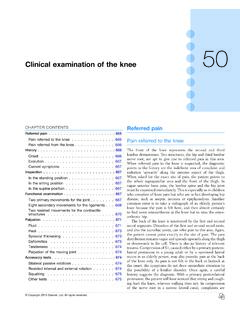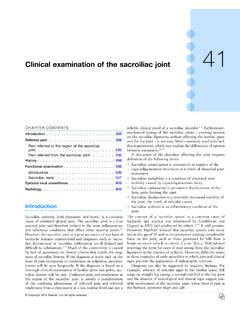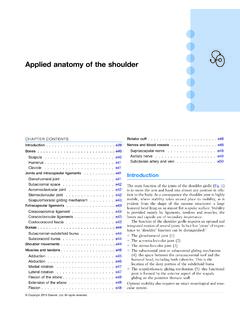Transcription of 25 - Clinical examination of the thoracic spine
1 Copyright 2013 Elsevier, Ltd. All rights Clinical examination of the thoracic spineCHAPTER CONTENTSI ntroduction ..365 Principal differences between the thoracic and the lumbar and cervical spines .. 365 Referred .pain ..366 Pain referred from musculoskeletal structures .. 366 Pain referred from visceral structures.. 369 History ..370 Pain .. 370 Paraesthesia .. 372 Anticoagulant treatment and bleeding disorders.. 372 Inspection .and .palpation ..372 Scoliosis .. 372 Kyphosis .. 372 Functional.
2 examination ..372 Standing .. 373 Sitting .. 374 Lying prone .. 376 Accessory .tests ..376 Technical .investigations ..381 IntroductionThoracic or abdominal wall pain is a common complaint and poses a major diagnostic challenge to physician and pain is often referred from visceral disorders, although the frequency of musculoskeletal lesions of the thorax and the abdomen should not be underestimated. A physician not familiar with the musculoskeletal disorders of the region could be tempted to ascribe unexplained pain to vague lesions such as intercostal neuralgia, neuritis, cardiac neurosis, pleurodynia or rib syndromes.
3 Again, lack of an exact diagnosis leads to inadequate and unsuccessful treatment. The absence of a precise (orthopaedic) diagnosis can, to a certain extent, be a consequence of the complexity of the region itself. However, another important reason is the lack of an appropriate Clinical approach to this part of the body. Thorough examination should not be restricted to the routine visceral examination ( auscultation, percussion and palpation) but also must include proper orthopaedic and neurological tests.
4 Although a large number of reliable technical investigations for detecting all types of visceral disorders are available, the same cannot be said when it comes to musculoskeletal disorders, for which technical investigations are often of limited diagnostic , the thoracic region is approached in a different way from the cervical or the lumbar spine because it behaves differently in many differences between the thoracic and the lumbar and cervical spinesVisceral .versus .musculoskeletal .painBecause referred pain from visceral problems can mimic pain of musculoskeletal origin and vice versa, the first step towards diagnosis must always be to differentiate these two categories.
5 The character of the pain is usually of little help in the dif-ferential diagnosis because it has the same features in both. Pain referred from heart, lungs and intestines is usually poorly localized and vaguely delineated, and is referred to a segmental or multisegmental distribution. The behaviour of the pain may also mislead the examiner. One of the main characteristics of pain in lesions of moving parts is that it is brought on by posture and movement. This is also the case in thoracic lesions: if the patient s symptoms depend on activity rather than on visceral function, a cause originating from moving parts should be considered.
6 However, it is important to keep in mind the The thoracic Spine366fact that posture, physical activity, a deep breath or a cough may also influence visceral pain in the thorax or best method of differentiating is to work in two com-plementary ways: exclusion of any visceral disorder through a thorough internal check-up, together with positive confirma-tion of a provisional orthopaedic diagnosis (Fig. ). This routine will also safeguard against unnecessary technical inves-tigations and delays in diagnosis and 3 Discal.
7 LesionsDiscodural and discoradicular interactions are well-known causes of cervical and lumbar a discodural lesion, a shifted component of the disc impinges on the dura and causes pain that has multisegmental characteristics (crossing the midline and occupying several der-matomes). Discodural conflicts are characterized by two sets of symptoms and signs: articular and dural (see Ch. 33).In a discoradicular lesion, the subluxated disc component impinges on the nerve root and its dural sleeve. The pain and paraesthesia that result are strictly segmental.
8 Discoradicular conflicts are characterized by three sets of symptoms and signs: articular, root and lesions also commonly occur in the thoracic spine but often show characteristics that are quite different from those found at the lumbar and cervical spines. The articular signs are subtle: a discodural interaction at the cervical or lumbar level usually presents with a clear partial articular pattern: some movements hurt or are limited and others do not, always in an asymmetrical way. This is not so in the thoracic spine .
9 Because of the rigidity of the thorax, such an obvious pattern is seldom found. Very often, only one of the six passive movements, usually a rotation, is positive and then only slightly so. Therefore diagnosis in the thoracic spine is more tentative and may have to be based on smaller, subtler abnormalities. Neurological deficit is seldom encountered in a thoracic disc lesion: whereas some degree of neurological deficit is a common finding in cervical or lumbar posterolateral disc lesions, muscular weakness is rarely detectable in thoracic discoradicular lesions.
10 Also, disturbance of sensation is very rare. This absence of neurological signs is probably the outcome of the location of the nerve root in the intervertebral foramen, where it lies mainly behind the Fig Routine for differentiation between thoracic and abdominal wall pain. Orthopaedic lesionMusculoskeletalexaminationis positiveVisceralexaminationis negativeDiscoduralDiscoradicularNon-disc al lesionlower aspect of the vertebral body and less behind the disc (see online chapter Applied anatomy of the thorax and abdomen).







